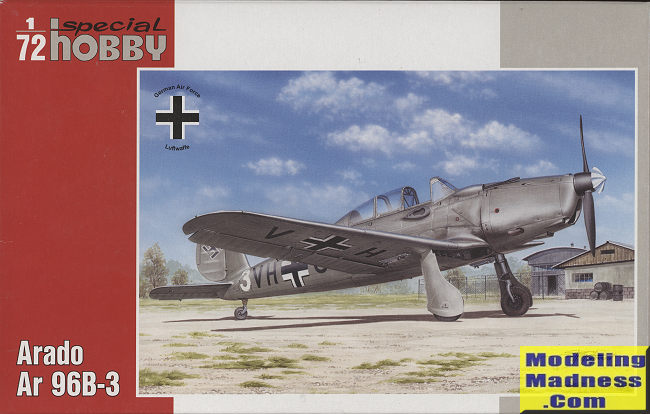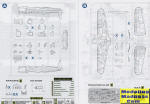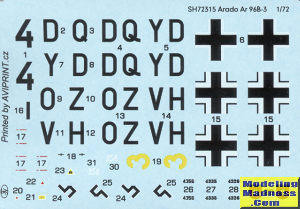
| KIT #: | SH 72315 |
| PRICE: | 288.43 Koruna |
| DECALS: | Two options |
| REVIEWER: | Scott Van Aken |
| NOTES: |

| HISTORY |
The Arado Ar 96 was a successful single-engine, two -seat advanced trainer used by the German Luftwaffe during and immediately prior to World War II. Designed in 1936 in response to a Reich Air Ministry requirement as a clean, low-wing monoplane of all-metal construction, the Arado trainer was quite modern at the time, using many light alloys. It was designed to fill the gap between the biplanes employed for basic training and the advanced monoplane fighters just entering service, in particular the Messerschmitt Bf 109.
The Arado Ar 96 prototype flew for the first time in 1937, powered by a 179 kW (240 hp) Argus As 10c engine. Over 11,000 were build, most of them by companies other than Arado.
The Ar 96 was used for advanced, night and instrument-flying training. Famously, during the evening of 28 April 1945, pilot Hanna Reitsch and then-Luftwaffe head Generalfeldmarschall Robert Ritter von Greim were flown out of Berlin under Soviet fire in an Arado Ar 96 trainer. The aircraft took off from an improvised airstrip in the Tiergarten, piloted by a Luftwaffe sergeant.
Production was also undertaken by Letov and the Avia factory in occupied Czechoslovakia, where manufacturing continued for some years after the war, being designated the Avia C-2B.
A wooden version, known as the Ar 396, was built in France and was designated the SIPA S.10. Further developments were the SIPA S.11 (armed version), and the SIPA S.12, a metal version; 188 of all versions were produced until 1958. The S.11 was operated with some success in Algeria, carrying machine guns, rockets and light bombs.
The B-3 variant, and subject of this kit, was built solely at the Avia plant with 243 examples constructed between 1941 and 1943.
| THE KIT |
 I
have always felt that MPM/Special Hobby kits are, to put it mildly, a bit
overdetailed. I mean they generally include photo etch bits that are so
tiny, that the majority of us will never get them correctly installed, or
will lose a significant number of them. For instance, the dozens of teensy
vortex generator rectangles for the rear fuselage of an F-86D, or the
equally Lilliputian throttle and instrument panel levers included in this
kit.
I
have always felt that MPM/Special Hobby kits are, to put it mildly, a bit
overdetailed. I mean they generally include photo etch bits that are so
tiny, that the majority of us will never get them correctly installed, or
will lose a significant number of them. For instance, the dozens of teensy
vortex generator rectangles for the rear fuselage of an F-86D, or the
equally Lilliputian throttle and instrument panel levers included in this
kit.
 Be
that as it may, this is undoubtedly the most detailed of the three kits that
have been produced of this aircraft in this scale. As you'd expect, the
cockpit has three piece instrument panels that consist of the etched face,
acetate instruments and a plastic backing (along with the aforementioned
tiny levers). There are seat harnesses in p.e. for both seats and you get
the opportunity to cut off the plastic rudder pedals and install photo etch
replacements. In between the front and rear
seats is a small bulkhead that has atop it, a resin and p.e. roll over
brace.
Be
that as it may, this is undoubtedly the most detailed of the three kits that
have been produced of this aircraft in this scale. As you'd expect, the
cockpit has three piece instrument panels that consist of the etched face,
acetate instruments and a plastic backing (along with the aforementioned
tiny levers). There are seat harnesses in p.e. for both seats and you get
the opportunity to cut off the plastic rudder pedals and install photo etch
replacements. In between the front and rear
seats is a small bulkhead that has atop it, a resin and p.e. roll over
brace.
Before trapping the cockpit assembly between the fuselage halves (which have nice interior framework detail0, you are provided with a four piece oil cooler assembly that fits behind a flat engine detail piece that shows a part of the cylinders. The other kits just have a blank plate. Atop the assembled fuselage is a single canopy piece with a couple of small p.e. hand holds that should be installed into the corners of the windscreen. A machine gun housing fits just behind the engine cowlings on the upper side and there is a tear-drop shaped attachment point of some sort on the right fuselage next to the student.
Wings are a single lower piece with two upper halves. Before attaching those, there is a three piece wheel well section to install. Under the wings are bomb racks that are made of a resin base with photo etch anti-sway braces. These will hold the resin bombs should you wish to install them. At the very front of the nose is the forward cowling piece with two resin intakes on either side and a pair of elbow exhaust.
Landing gear is nicely done with photo etch oleo scissors and resin wheels. Gear doors are simple butt joins. Finally, a bunch of p.e. control surface actuating rods and probes. There is a T shaped one you have to make that is 2 x 3.5 mm. Finally, the prop is assembled with its resin hub and separate blades.
 Instructions
are nicely done with the usual Gunze paint references. Three options are all
painted overall RLM 02 and are from 1943. The box art plane was with the
night fighter school, NJS 1. The other two have yellow rear fuselage bands.
One with JG 107 has a white spinner and black areas on the lower fuselage
along with areas of fresh paint. The other is with JG 101 and is similarly
marked, but without the white spinner and with a unit badge on the forward
fuselage. Decals are very nicely printed. If you want something different,
there are aftermarket sheets for this aircraft.
Instructions
are nicely done with the usual Gunze paint references. Three options are all
painted overall RLM 02 and are from 1943. The box art plane was with the
night fighter school, NJS 1. The other two have yellow rear fuselage bands.
One with JG 107 has a white spinner and black areas on the lower fuselage
along with areas of fresh paint. The other is with JG 101 and is similarly
marked, but without the white spinner and with a unit badge on the forward
fuselage. Decals are very nicely printed. If you want something different,
there are aftermarket sheets for this aircraft.
| CONCLUSIONS |
Of the three kits that have been manufactured, this one looks to be the most detailed of the three. Of course that detailing comes at a price and not just monetary, but extra fiddlyness in terms of small p.e. parts. For those that can handle that, this would be one to get.
| REFERENCES |
https://en.wikipedia.org/wiki/Arado_Ar_96
July 2019
Copyright ModelingMadness.com. All rights reserved
If you would like your product reviewed fairly and fairly quickly, please
contact
the editor or see other details in the
Note to
Contributors.
Back to the Main Page
Back to the Review
Index Page
Back to the Previews Index Page